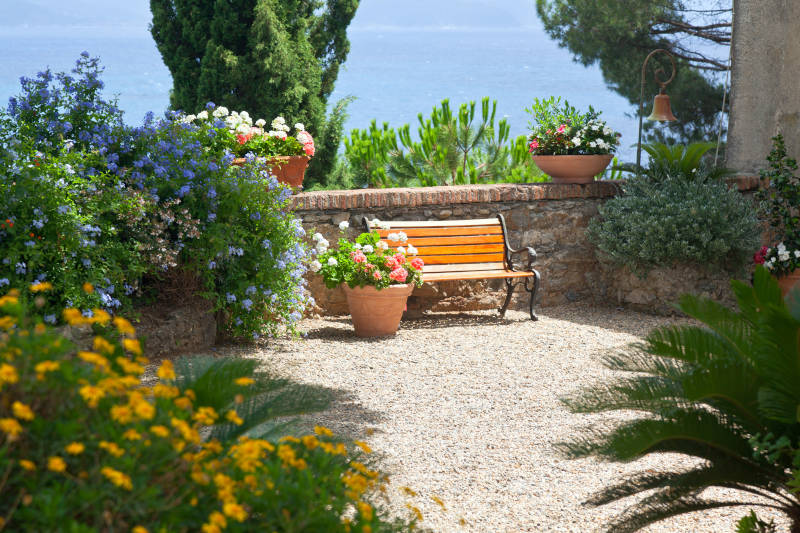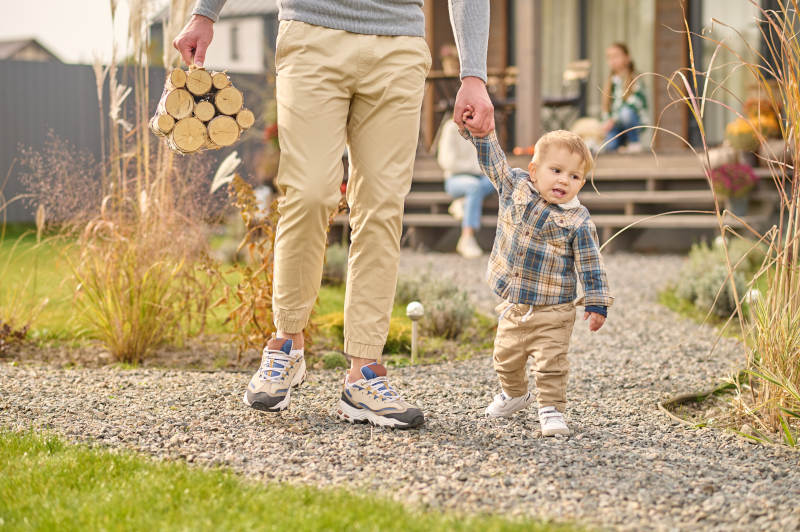Using pea gravel is one of the most popular picks for homeowners when it comes to adorning their outdoor living spaces. It looks elegant, is affordable, and is easy to install. Today, we’ll dig deeper into pea gravel patio pros and cons to help you decide whether or not it fits your preference and lifestyle!

Pea Gravel Patio Pros and Cons at a Glance
Here’s a quick look at what homeowners like and dislike about pea gravel patios:
| Pros | Cons |
| Affordable than most other options | Scatters easily, which can be messy |
| Easy to install | Prone to sinking under heavy objects |
| Easy to manipulate for enhancing aesthetics | Potential for weed growth |
| Low-maintenance | |
| Natural-looking and smooth finish |
Pros of Using Pea Gravel Patio
Going for the pea gravel option has considerable benefits that homeowners can attest to. Here are some reasons to jump on the bandwagon and try this option.
Affordable
The cost of setting up your patio matters, especially if you’re on a tight budget. Pea gravel is cheaper than its popular competitors, like concrete pavers, brick, and stamped concrete. Here’s a quick price comparison for these patio types for your reference:
- Pea Gravel – $6 to $10 per square foot
- Concrete Pavers – $13 to $20 per square foot
- Stamped Concrete – $6 to $13 per square foot
- Brick – $14 to $20 per square foot
Easy to Install
You don’t need to hire professionals to install a pea gravel patio. Once you’ve decided on a location, you can do the digging yourself. You can dig about three to six inches deep, then pour the pea gravel.
Putting up pavers to serve as edges is optional, but many prefer doing it to achieve a cleaner contour.
Customizable to Fit Different Styles
There’s a lot of room to play around when customizing pea gravel. Because these natural stones don’t have a uniform shape, they blend well with just about any line and size. You also don’t have to worry about flattening their, as their variety of shapes can easily be moved around to fit an outline.
Low-Maintenance
Pea gravel patio requires minimal maintenance, as you don’t need to paint or reseal it. It also doesn’t decompose and is excellent at draining water. You’ll only need to rake it once in a while to even the surface.
Looks Natural and Has a Smooth Finish
One of the best things parents love about pea gravel is its smooth feel on foot. Kids are notorious for playing barefoot, and this flooring in your courtyard offers a bit of comfort, knowing the materials are unlikely to hurt their feet while moving around.
Pea gravel’s multicolored variety is also natural and blendable, making them an easy addition to your veranda’s aesthetics.

Cons of Using Pea Gravel Patio
While pea gravel is easy to secure and set up, some factors may affect your overall satisfaction with this patio. Below are the cons that landowners complain about.
Unstable and Messy
Pea gravel’s smooth texture and irregular shapes make it prone to scattering. Keeping them compact and immovable is also unlikely. Therefore, movements from kids, pets, and a small crowd can potentially disturb its pristine look.
Prone to Sinking Under Heavy Weight
Because pea gravel patios are less compact than other types, like concrete, you’ll see yours sinking beneath objects with heavy weight. Standard furniture like wooden sofas and dining sets might feel uneven once one of their edges sinks due to constant movement.
High Potential for Weed Growth
Where there is soil and sunlight, weeds are likely to grow. Many homeowners directly pour pea gravel on the flattened ground without using any landscaping fabric. While pea gravel can block the sun from penetrating the soil, it’s not foolproof.
Any disturbance on the surface can make one portion of your patio more exposed to sunlight than the rest. Eventually, you’ll see those unwanted greens sprouting all over the place.
Tips on How to Install Pea Gravel Patio the Right Way
While pea gravel has considerable cons, its final look and pros can be too desirable for some people to pass up. Here are ways to mitigate its negatives so that you get the full benefit of this option without much hassle.
- Decide on an area where you want to install the patio, and size it up nicely. Use spray paint or any markers to define its edges.
- When digging, go for the recommended three to six-inch depth to establish a stronger base for your pea gravel.
- Once done digging, remove all dirt and tamp the ground to make it more compact.
- Use a landscaping fabric to cover the ground.
- Install edgings or borders to define the exact shape you want for your patio.
Once you’re all set, consider picking sets of furniture that won’t easily budge. The idea is to keep them grounded on the patio. However, the heavier they are, the more likely they are to sink.
Is Pea Gravel Patio for You?
Whether or not pea gravel works depends on factors like lifestyle and design preference. It might be a worthy choice if you find the following true:
- You love a natural-looking patio
- You’re on a tight budget or want to install the space yourself
- You’re not expecting so much activity on it, just pure aesthetics
- You don’t have time for regular maintenance
- You’re not planning to install heavy objects on top of it
- You want something you can easily install and replace when needed.
Final Thoughts
Pea gravel patios are one of the most practical exterior designs homeowners love to invest in. Its price and ease of installation are ideal, and you can customize it the way you like.
While the patio still has some cons, as with the rest of your options, if you install it right, you’ll enjoy its perks with minimal stress. Find a suitable spot in your backyard and see which part looks awesome in multicolored pebbles!

